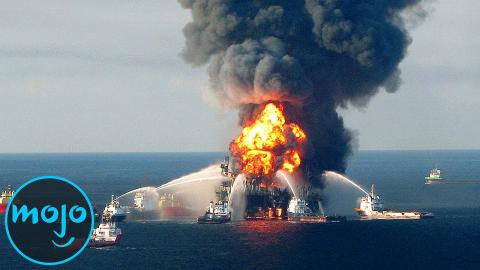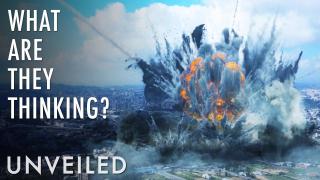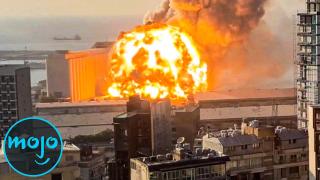Top 10 Most EXPENSIVE Mistakes of the Century (So Far)

#10: Garbage Treasure
2013 In 2013, James Howells had a clear-up at his house in Newport, Wales. Intending to throw out an old, empty hard drive, the IT worker mistakenly placed a second identical one in the bin instead. However, that device held a mountain of 8000 bitcoins, which he purchased in 2009. At one point in 2022, that was worth an estimated $181 million! Howells has since lobbied the Newport council to let him go landfill diving, but they’ve rejected him repeatedly due to the “environmental impact.” Yet each year, a further 50,000 tons of garbage are added. In 2022, Howells assembled a team of experts for an excavation that would cost $11 million, but an approval from the council seems to be a long shot.
#9: The Japan Typo
Top 10 Most Expensive Mistakes In History
2005 We’ve all made typos. Sometimes it’s gotten us in hot water with family and friends, but for most of us, such a mistake doesn’t usually cost millions of dollars. That is, unless you’re the unnamed employee at Japanese brokerage firm Mizuho Securities who, in 2005, made a big whoopsie. The trader meant to sell one share in a company called J-Com for 610,000 yen, or $5,041 at the time. Instead, they reversed those numbers and accidentally sold 610,000 shares for one yen, which is less than a cent. Yikes! The erroneous transaction was processed anyway, which lost the company at least $225 million! We wouldn’t be looking forward to our performance review, if we were that employee!
#8: Education Error
2010 When attempting to secure a grant worth millions, double-checking your work is a must. The state of New Jersey learned this the hard way in 2010. While submitting a high-profile application for a federal education grant, a member of then-Governor Chris Christie’s administration made a terrible mistake. Instead of inputting budget figures for the years 2008 and 2009, they entered information for 2010 and 2011. This seemingly minor error lost the state much-needed points to rank higher in the competition, putting them just behind Ohio, which came in 10th place. As a result, New Jersey narrowly missed out of education funding potentially worth $400 million. In the aftermath, Christie fired his education commissioner, Bret Schundler, for the mistake.
#7: BlockFlix
2000 Love ‘em or hate ‘em, no one can argue with the fact that Netflix changed the game when it comes to content distribution. And things could’ve looked so much different had Blockbuster been open-minded in 2000. Back then, still a DVD rental company, Netflix met with the then-leaders of the market to propose a buyout of $50 million. According to co-founder Marc Randolph, Blockbuster CEO John Antioco struggled not to laugh at the idea before turning them down. Following the rejection, Netflix eventually became stiff competition for Blockbuster, and played a role in the company’s ultimate failure. They have since transitioned into streaming, as well as film and TV production, generating a revenue of around $31.6 billion in 2022 alone.
#6: The Cerro Grande Fire
Top 10 Most Expensive Product FAILS
2000 In May 2000, the National Park Service in New Mexico started a controlled fire at the Cerro Grande peak. This effort, which was carried out partly to reduce the risk of a wildfire, ended up causing the very event it sought to prevent. As it was springtime, the dry and windy conditions caused the blaze to get out of control. And it certainly didn’t help that the crew tasked with tending to the fire was way too small to deal with it. Six days after the flames were ignited, the nearby town of Los Alamos had to be evacuated, and later that night, 235 homes were destroyed. Eventually, it was extinguished, leaving in its wake an estimated damage of $1 billion!
#5: The Sinking Submarine
Top 10 Medical Miracles of the Century (So Far)
2013 In 2013, Spain wanted to make waves in the military world by commissioning the state-owned firm Navantia to build four S-80 submarines. However, the engineers had miscalculated the weight of the submarines, making them 110 US tonnes too heavy. This meant they would sink right into the ocean’s bed. Having already spent $650 million, the Spanish government spent millions more to rectify the problem by making the submarines longer. This proved to be yet another costly mistake, as the vessels then became too long to fit in their dock. (Xref) The U.S. had a similar problem in 2008, when one of its most expensive aircrafts - the B-2 Spirit stealth bomber - crashed following a miscalculation due to the presence of moisture on its sensors.
#4: Howie Hubler's Howler
2008 In the lead up to the subprime mortgage financial crisis of the late 2000s, there was one person involved that really, really didn’t help matters. His name? Howie Hubler. First as a trader and then as the head of the Global Proprietary Credit Group at investment firm Morgan Stanley, Hubler was repackaging risky mortgages and selling them to investors. He did this expecting the repackaged mortgages to be less risky, only to later realize that they were, in fact, worthless. Hubler’s actions cost his company an enormous $9 billion, the largest single trading loss at the time. For causing this massive error, Morgan Stanley let Hulber resign from the company, complete with a severance package reportedly worth $10 million.
#3: Station Sadness
Why NASA Plans To Crash the International Space Station | Unveiled
2014 Trains are vital infrastructure. But they’re not so useful if they cannot actually transport people. In 2014, France’s state-owned railway company SNCF decided to revamp their service with a new fleet of trains. Altogether, they purchased around 2,000 of them at the cost of $20.5 billion. However, what they failed to realize was that the measurements sent to the manufacturers were tailored to the more recent railway stations. This meant that the new trains were too large to pass through about 1,300 of the country’s older stations. The SNCF reportedly blamed the 1997 split of the railway network for the miscommunication of sizes. Regardless, the estimated cost to widen the platforms was around €50 million.
#2: The Deepwater Horizon Oil Spill
Top 10 Most Expensive Accidents in History
2010 Multinational oil company BP realized the cost of their shortcuts in 2010 when an explosion rocked their Deepwater Horizon drilling rig off the U.S. coast. Investigations pointed towards the cheap materials used in building the oil wells as the cause of the incident. In all, about 210 million gallons of oil spilled into the Gulf of Mexico, in what is now regarded as one of the biggest environmental disasters in history. This significant amount completely dwarfs that of the Prestige oil spill, which occurred in Spain and resulted in the loss of 17.8 million gallons of oil. Similar to the Deepwater incident is the 2011 Fukushima nuclear disaster in Japan, which also could’ve been prevented by proper maintenance of the nuclear plant.
#1: AOL's Fall
Top 30 Creepiest Mysteries of the Century (So Far)
2000 In 2000, AOL splashed out $182 billion to merge with Time Warner. This deal created a partnership that was said to be valued at $350 billion. With all that cash, expectations were incredibly high that this pairing would be very fruitful for the firms involved. But then, only months later, the dot-com internet bubble burst. Exasperated by a recession, the merger began to look really bad. By 2003, AOL Time Warner announced a loss of $98.7 billion, a record amount in corporate history! In 2009, Time Warner cut their losses and let AOL run free. They then hopped around industry giants afterwards, from Verizon in 2015, before being sold alongside Yahoo for $5 billion to Apollo Global Management in 2021.







